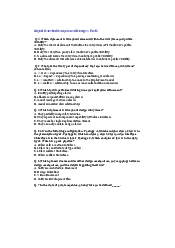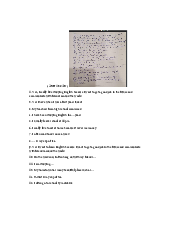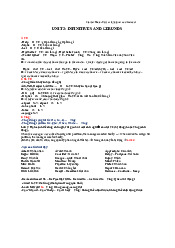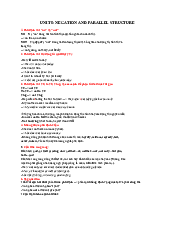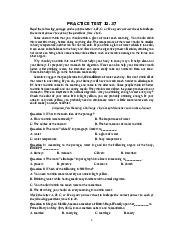






Preview text:
PRACTICE TEST 12.72
Read the following passage and mark the letter A, B, C, or D to indicate the correct answer to each of the questions. The ballpoint pen
Most of us have at least one, but how did this popular item evolve?
One morning in 1945, a crowd of 5,000 people jammed the entrance of Gimbels Department Store in
New York. The day before, Gimbels had placed a full-page advertisement in the New York Times for a
wonderful new invention, the ballpoint pen. The advertisement described the pen as 'fantastic' and
'miraculous'. Although they were expensive, $12.50 each, all 10,000 pens in stock were sold on the first day.
In fact, this 'new' pen was not new at all. In 1888, John Loud, a leather manufacturer, had invented a
pen with a reservoir of ink and a rolling ball. However, his pen was never produced, and efforts by other
people to produce a commercially successful one failed too. The main problem was with the ink. If it
was too thin, the ink leaked out of the pen. If it was too thick, it didn't come out of the pen at all.
Almost fifty years later, in 1935, a newspaper editor in Hungary thought he spent too much time filling
his pens with ink. He decided to invent a better kind of pen. With the help of his brother, who was a
chemist, he produced a ballpoint pen that didn't leak when the pen wasn't being used. The editor was
called Ladislas Biro, and it was his name that people would associate more than any other with the ballpoint pen.
By chance, Biro met Augustine Justo, the Argentinian president. Justo was so impressed with Biro's
invention that he invited him to set up a factory in Argentina. În 1943, the first Biro pens were produced.
Unfortunately, they were not popular, since the pen needed to be held in a vertical position for the ink to
come out. Biro redesigned the pen with a better ball, and in 1944 the new product was on sale throughout Argentina.
It was a North American, Milton Reynolds, who introduced the ballpoint pen to the USA. Copying
Biro's design, he produced the version that sold so well at Gimbels. Another American, Patrick Frawley,
improved the design and in 1950 began producing a pen he called the Papermate. It was an immediate
success, and within a few years, Papermates were selling in their millions around the world.
Question 1: People went to Gimbels to buy a ballpoint pen because ____________-
A. they couldn't get them anywhere else.
B. they thought the price was good.
C. they had never seen a ballpoint pen before.
D. they had been told how good the pens were.
Question 2: Why were early ballpoint pens not produced commercially?
A. They used too much ink.
B. They didn't work properly.
C. It cost too much to produce them.
D. Nobody wanted to buy one.
Question 3: Why was Ladislas Biro's pen better than earlier models?
A. It didn't need to be filled with ink as often.
B. It was easier to use.
C. It was designed by a chemist.
D. The ink stayed in the pen until it was needed.
Question 4: Biro's first commercially-produced pen
A. only worked if used in a certain way.
B. was produced in a factory owned by the Argentinian president.
C. was a major success. 1
D. went on sale in 1944.
Question 5: Patrick Frawley's pen ________________
A. was the USA's first commercially successful ballpoint pen.
B. took time to become successful.
C. was a better version of an earlier model.
D. was only successful in the USA.
Mark the letter A, B, C, or D to indicate the sentence that best combines each pair of sentences in the following questions.
Question 6: He isn't qualified. He is not given important tasks.
A. If only he were qualified and wouldn't be given important tasks.
B. He wished he hadn't been qualified and wouldn't have been given important tasks.
C. If he were qualified, he would never be given important tasks.
D. He wishes he were qualified and would be given important tasks.
Question 7: He started working in the World Bank. That was right after he had graduated from university.
A. No sooner had he started working in the World Bank than he graduated from university.
B. Before he graduated from university, he had started working in the World Bank.
C. No sooner had he graduated from university than he started working in the World Bank.
D. Hardly had he started working in the World Bank when he graduated from university.
Mark the letter A, B, C or D to indicate the underlined part that needs correction in each of the following questions.
Question 8: All camp attendants were sent a questionnaire eliciting demographic details, symptoms and
possible exposures, including food history and contact with other cases. A. and B. camp attendants C. eliciting D. exposures
Question 9: Scientists think there is water on Mars a long time ago. A. a B. on C. is D. think
Question 10: Voters and policymakers should hold school districts and its employees accountable for student learning A. should hold B. accountable C. student learning D. its
Mark the letter A, B, C, or D on your answer sheet to indicate the word(s) OPPOSITE in meaning
to the underlined word(s) in each of the following questions.
Question 11: We racked our brains but we couldn't come up with a solution. A. positively changed B. thought very hard C. thought quickly D. considered carefully
Question 12: Her graceful
performance of this traditional art form in the evening session was a real 2 source of pleasure. A. attractive B. effortless C. sophisticated D. inelegant
Mark the letter A, B, C, or D on your answer sheet to indicate the correct answer to each of the following questions.
Question 13: The growth in employment and wages gives consumers some spending __________ to
absorb the higher cost of energy. A. ability B. force C. energy D. power
Question 14: _____________trees around the house on the south and west sides, they can save up to about $300 a year. A. To plant B. Having planted C. They have planted D. Being planted
Question 15: ___________to the nearest city, we will have driven for 5 days. A. When we will get
B. While we are getting C. As soon as we got D. By the time we get
Question 16: Can I have a glass of water? I have got a ___________in my throat. A. duck B. frog C. chick D. goat
Question 17: Nothing, even A.I., can replace teachers __________it will be widely used in classroom. A. although B. because of C. despite D. because
Question 18: The 26th Annual Meeting of the Asia-Pacific Parliamentary Forum (APPF) ________in
Hanoi from January 18th to 21st, 2018. A. being held B. was held C. held D. will hold
Question 19: The map of the top ten most densely ________ countries in the world includes Monaco,
Singapore, Bahrain, Malta, and Bangladesh. A. population B. popularly C. populated D. populate
Question 20: Much of our knowledge about prehistoric animals comes from the study of ________ A. relics B. artefacts C. ruins D. fossils
Question 21: It's the first time she has enjoyed such a ___________ cake
A. Christmas tasty chocolate
B. tasty Christmas chocolate
C. chocolate Christmas tasty
D. tasty chocolate Christmas
Question 22: He was forced to ______________ his pride and asked if he could have his old job back. A. vomit B. chew C. swallow D. digest
Question 23: The longer Karen waited for the exam result, ________________she became. A. most anxious B. the more anxious C. more anxious D. the most anxious
Question 24: You will be brought before the disciplinary panel to ____________ your behavior.
A. turn down ( từ chối) B. take up C. account for D. put down
Question 25: Inspector Moro was determined to get to the __________ of the mystery A. ground B. bottom C. tune D. end
Question 26: People are worried ___________ losing their jobs during the Covid-19 pandemic. A. about B. of C. at D. over
Question 27: The journey soon became tedious, __________ 3 A. won't it B. wasn't it C. didn't it D. doesn't it
Mark the letter A, B, C or D to indicate the sentence thar is closest in meaning to each of the following questions
Question 28: It's possible for us to borrow books from the school library.
A. We have to borrow books from the school library,
B. We must borrow books from the school library
C. We can borrow books from the school library.
D. We should borrow books from the school library
Question 29: "It's me. I broke your vase." Jane said to Ann.
A. Jane admitted breaking Ann's vase.
B. Jane denied breaking Ann's vase.
C. Jane accused Ann of breaking her vase.
D. Ann prevented Jane from breaking her vase.
Question 30: The last time Susan went to school by bike was one year ago.
A. Susan didn't go to school by bike one year ago.
B. Susan went to school by bike for one year.
C. Susan has gone to school by bike for one year.
D. Susan hasn't gone to school by bike for one year.
Mark the letter A, B, C or D on your answer sheet to indicate the word CLOSEST in meaning to
the underlined word in each of the following questions.
Question 31: Ha Long Bay has attracted millions of visitors who come to enjoy its breathtaking views
and experience other activities. A. unbreathable B. unforgettable C. awe-inspiring D. heartbreaking
Question 32: At first, there was a lot of opposition from the parents of the disabled children as they
were not under the impression that their children could learn anything at all. A. didn't believe B. didn't support C. didn't report D. didn't declare
Mark the letter A, B, C, or D to indicate the word whose underlined part differs from the three in
pronunciation in each of the following questions. Question 33: A. manly B. dangers C. capable D. ancient Question 34: A. foods B. strikes C. creates D. hopes
Read the following passage and mark the letter A, B, C, or D to indicate the correct answer to each of the questions.
Perhaps the greatest invention in history is writing. The flexibility of writing is perhaps the key to
much of its power. But it may be that writing's very flexibility can be a curse as well as a blessing. A
common concern with oral histories is the possibility that the truth will get distorted over time and that
rumors will become truth. Written history evidences the same problem.
Throughout the centuries that writing has existed, forged documents have also existed. An ancient 4
letter supposedly written by the Roman emperor Constantine in the 4h century A.D. shows that the
duration of a document is not proof of its truth. For many centuries, the Catholic Church relied on this
letter to enforce the legitimacy of its rule and its land. The letter from Constantine stated that he had
become a Christian and donated a portion of his land to the Pope and to future Popes in the Catholic
Church. Although it is true that Constantine converted to Christianity, the letter itself was discovered to
be a forgery in the 15th century, and probably originated in the 8th century.
In addition to historical documents, great literature has also been forged. William Shakespeare, who
died in 1616, is perhaps the most famous author in the world. Wouldn't someone benefit if a long-lost
play was found? In 1796, William Henry Ireland announced that he had indeed found such a play
entitled Vortigern. He sold it to a London theater producer, but as soon as he handed over the script, the
producer immediately realized it was fake. He decided to produce it anyway as an April Fool's Day joke.
Some fake documents are easily debunked by highly literate people by comparing the suspicious
document to writing that was definitely written by the author in question. If the writing style does not
correspond to the known sample, it is not hard to declare the writing to be fake. However, it is not
always so easy to use writing style, grammatical patterns, and word usage as a basis for identifying the
real author of a of William Shakespeare.In 1989, literature professor Don Foster identified a poem called
"A Funeral Elegy" as the work of William Shakespeare. The work was added to collections of
Shakespeare’s work, but in 2002 it was re-classified as the work of another writer - and Foster, now aware of his mistake, agreed.
Question 35: The best title for this passage is ____________
A. Oral History vs. Written History
B. Types of Record History
C. How Do We Know If Shakespeare Wrote This?
D. Reliability and the Written Word
Question 36: According to the passage, why would the flexibility of writing be a curse as well as a blessing?
A. because power can be abused
B. because good tools can be difficult to find
C. because it cannot prevent forgery
D. because the truth can cause problems
Question 37: What happened as a result of the forged letter from Constantino?
A. The Church ruled land that did not belong to it for 1100 years,
B. Constantine mistakenly donated a portion of his land,
C. The forger may have deliberately misrepresented the facts.
D. Constantine converted to Christianity.
Question 38: Which of the following statements would the author probably agree with?
A. Writing style cannot always identify a forgery,
B. Oral history is more reliable than written history,
C. History is full of fake documents, so it is not trustworthy,
D. Analyzing grammatical patterns and word usage is more reliable. 5
Question 39: The underlined word "debunked” in the passage is closest in meaning to ___________ A. destroyed B. laughed at hunked C. proved false D. produced
Question 40: The underlined word "it" in the passage refers to __________ A. a written text B. the poem C. writing style D. Shakespeare's work
Question 41: Based on the passage, it could be suggested that Don Foster's error was __________
A. being blind to his bias
B. purposely misinterpreting the facts
C. deliberately misrepresenting the facts
D. mistakenly interpreting the poem
Mark the letter A, B, C or D to indicate the word that differs from the other three in the position
of the primary stress in each of the following questions.
Question 42: A. maximum B. applicant C. inflation D. character Question 43: A travel B. suggest C. sustain D. involve
Mark the letter A, B, C or D on your answer sheet to indicate the sentence that best completes the following exchanges.
Question 44: Peter and Mary are talking about social networks.
- Peter: "Using social networks may have negative effects on students.
- Mary: “____________It distracts them from their studies." A. That's quite true B. I don't quite agree C. You're wrong D. I'm not sure about that
Question 45: Two high school students, Jane and John, are talking in the school yard. - Jane: “ _____________”
- John: Thanks a bunch. Got it from my brother on my birthday
A. Let's go for a ride on my new motorbike!
B. I'm bored! How about going out for lunch?
C. That's a lovely dress you're wearing.
D. Would you like some more coffee?
Read the following passage and mark the letter A, B, C or D to indicate the correct word that best fits each of the blanks.
For the Japanese, Mount Fuji has long been the ultimate symbol of beauty. It is incredibly beautiful
when seen from any (46) __________ at all times of day and in any season. But the mountain does not
only play a major part in the landscape - it has also inspired poets and artists for centuries and has come
to be (47) ________ with Japan itself. From the top, the sides of the mountain slope away, then flatten
out before reaching the ground. Here, at ground level the foot of the mountain forms an almost perfect circle.
To the north of Mount Fuji lie the famous 'Five Lakes'. The lakeside area is a sea of colour in spring 6
when the first trees are flowering, and it is a stunning sight in autumn when the leaves turn first brilliant
red, then many shades of brown. (48) _________, many of the best views of Mount Fuji are from these
lakes, (49) _________still waters reflect the mountain's beautifully symmetrical outline like a mirror.
Both Mount Fuji and its lakes are volcanic (50) _____________ origin, and that is probably why
traditional stories say that Mount Fuji appeared overnight; and, for the same reason, it may one day vanish just as suddenly. Question 46: A. corner B. curve C. edge D. angle Question 47: A. named B. identified C. considered D. recognized Question 48: A. Nevertheless B. Especially C. Indeed D. Given Question 49: A. whose B. that C. where D. which Question 50: A. by B. in C. with D. of 7
